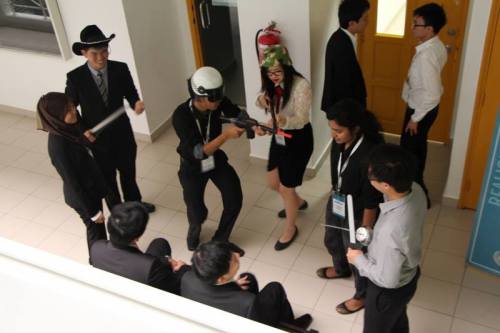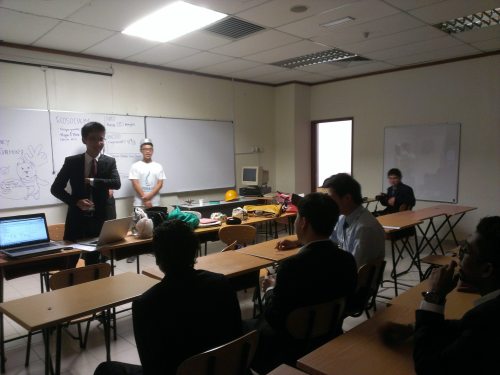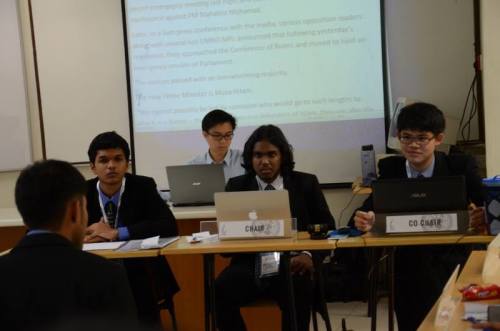
Crisis is one of the biggest parts of Model UN, and running a Crisis is probably the most challenging, enjoyable and rewarding experiences an MUN enthusiast could ever have! But unlike any other MUN committee, planning and executing a Crisis requires a lot of troubleshooting and thinking ahead. Here are my experiences designing one Crisis and chairing another at two conferences over the summer back home in Malaysia:
#1. Deciding on a Crisis format
Should it be a single-cabinet affair? Or a multi-cabinet battle royale? Will delegates battle in the future, or attempt to rewrite history? Will everything revolve around one major event or a series of events over a politically turbulent period of time?
Deciding what sort of Crisis to run turned out to be crucial. At the end of the day, the Secretariat and Crisis Team opted for single cabinet crises: the major deciding factor was the fact that Crisis simulations were something new to Malaysia’s relatively new but fast-growing MUN scene, as many of our delegates would either be new to Crisis or MUN in its entirety. A single cabinet format gave delegates a more specific frame of reference and made it easier for us to run as staff members. A multi-cabinet crisis could also easily end up being a lopsided simulation if the delegates in each room were not equally proactive and quick to learn, so one cabinet it was.
We also decided to make both simulations historical crises, hoping history would be something a little more concrete for delegates to base their strategies and actions off of.
The starting point for our first Crisis was a fierce internal battle over control of the government and country’s largest political party. The point of this was to split the room in two and pit delegates against each other. This would help avoid the situation in which they would stall our developments by defaulting to a consensus-based approach to the crisis.
Our second Crisis was a little different; set just after the formation of Malaysia, we attempted to pit our delegates against invasive external forces.
Both proved to work fairly well as a starting point after delegates had gotten the hang of participating in the crisis. The premise of both simulations also gave them a fair bit of information to rely on in building their characters and motivations. Which worked better? I think the second was a little more successful in getting delegates taking action.
By having them start out united, the room was a little quicker on the take and were more active with directives. Then, of course, the hammer dropped and we began splitting them apart, as any challenging crisis would do – which brings us to:
#3. Creating a timeline
Often considered an essential part of the Crisis designing process, the crisis timeline was essential to the dynamics of the committee. Having a timeline – or multiple possible timelines and mechanisms to allow some flexibility in the simulation – proved crucial to striking a balance between keeping delegates in check (peace never comes after just an hour of negotiating) and allowing delegates to have little victories along the way (rage quit is a very real phenomenon).
Our first 1987 crisis was structured along a two-part diverging timeline: first the delegates would split into factions and struggle to take control over the party. Depending on which side found success, the second part of the timeline would kick in as the new status quo dealt with a series of external political threats while contending with the defeated internal faction looking to reassert some control.
The first part was therefore very much in the hands of the delegates, then. The second part didn’t operate on a divergent timeline structure; instead the plan was to lob separate threats at delegates as the setting shifted from 1987 to 1988, and onwards.
Our second crisis took a more traditional approach to the timeline, with our Crisis Director putting together a very comprehensive plan for the delegates and having their reactions to one threat bear directly on the next crisis development. The time setting mostly remained the same, then.
Along the way, we also threw in a few mini-quests and subplots with personal scandals affecting individual delegates, conspiracies involving groups of delegates, and opportunities for defection and spying in addition to some other curve balls.

What happens when your delegates seem determined to push against your plans? Our first Crisis gave us a bit more flexibility when it came to this, since most major crisis developments were separate – so delegates could more heavily influence the outcome of a particular subplot. Given that we also had multiple plot threads to pull on, we could expedite or delay developments on individual plots to influence delegates.
Sometimes you try to rope delegates into very specific plans or conspiracies. Things predictably get difficult when they try not just to double-cross their fellow delegates, but their Crisis Directors as well! In one scenario we had a delegate ‘betray’ our plans of assassinating a room of delegates; thankfully we had a backup assassin in the Crisis Team.
Crisis number two’s more structured timeline seemed like it might prove less flexible and more challenging for the Team. But it was well-planned and just about every major outcome was accounted for in advance, so we reacted to the delegates’ scheming fairly well.
Our arsenal of mini-games and side stories came in very handy as well when it came to balancing the dynamic of the room. When a delegate would get too influential or begin dominating proceedings too much, we could remove him or her from the equation temporarily via a kidnapping. Or we could discredit them a little with a scandal. Once to prevent delegates from solving a major problem too early, we staged mass arrests and physically separated the room for a while.
Even with the aforementioned steps, everything ultimately leads to…
#5. The Endgame
How does your story conclude? Most crises opt for escalation, running up the panic to seizure-inducing levels and sending delegates into a tailspin before ending things on a high. By and large that’s what we did as well. To end with a whimper rather than a bang would have put a bit of a damper on proceedings.
How you execute that ending is a different matter. Some endings are logical extensions of the storyline delegates have been following. In these situations the timeline planning should kick in and account for multiple possible endings, then. But as a backup you could also have a surprise ending, with a sudden update leaving delegates scrambling for the 10 minutes or so left on the clock. The 1987 crisis saw a three-pronged update involving snowfall in Southeast Asia, an impending asteroid crash and a Hunger Games-imposing insurgency by foreign militants. The 1963 crisis ended with the creation of a socialist state ruled by an absolute monarchy.
Both had delegates excited and, most importantly, hungry for more, which was a good way to end the Crises. What seemed to make it work was that delegates were given the chance to really influence events along the way and feel like they could deal with the major issues they were presented with. The somewhat apocalyptic endings were just a bonus feature to end the day on an energetic note.

What could be improved? We learned that the details matter. The second Crisis had much more professional-looking updates- newspaper articles looked more like newspaper articles than word documents, for example. These little things make the experience just that little bit more immersive, and helps delegates get into their roles more enthusiastically.
We could also have helped out our delegates a little more too, given how many were first-timers. While we tried to highlight just how creative characters could be in issuing directives and strategizing, I think many staff members took a while to understand just how much they could really do. Perhaps starting delegates off with a more clearly-defined portfolio of powers (and a list of suggestions for directives and actions) may have spurred a little more activity on the first day, which in both cases was where the Crises lagged somewhat.
Still, it was a hugely enjoyable experience and I feel like every Crisis is one where you pick up something new. The format offers endless ways to creative innovative ideas and I’m definitely looking to plan and direct one again some time soon.


